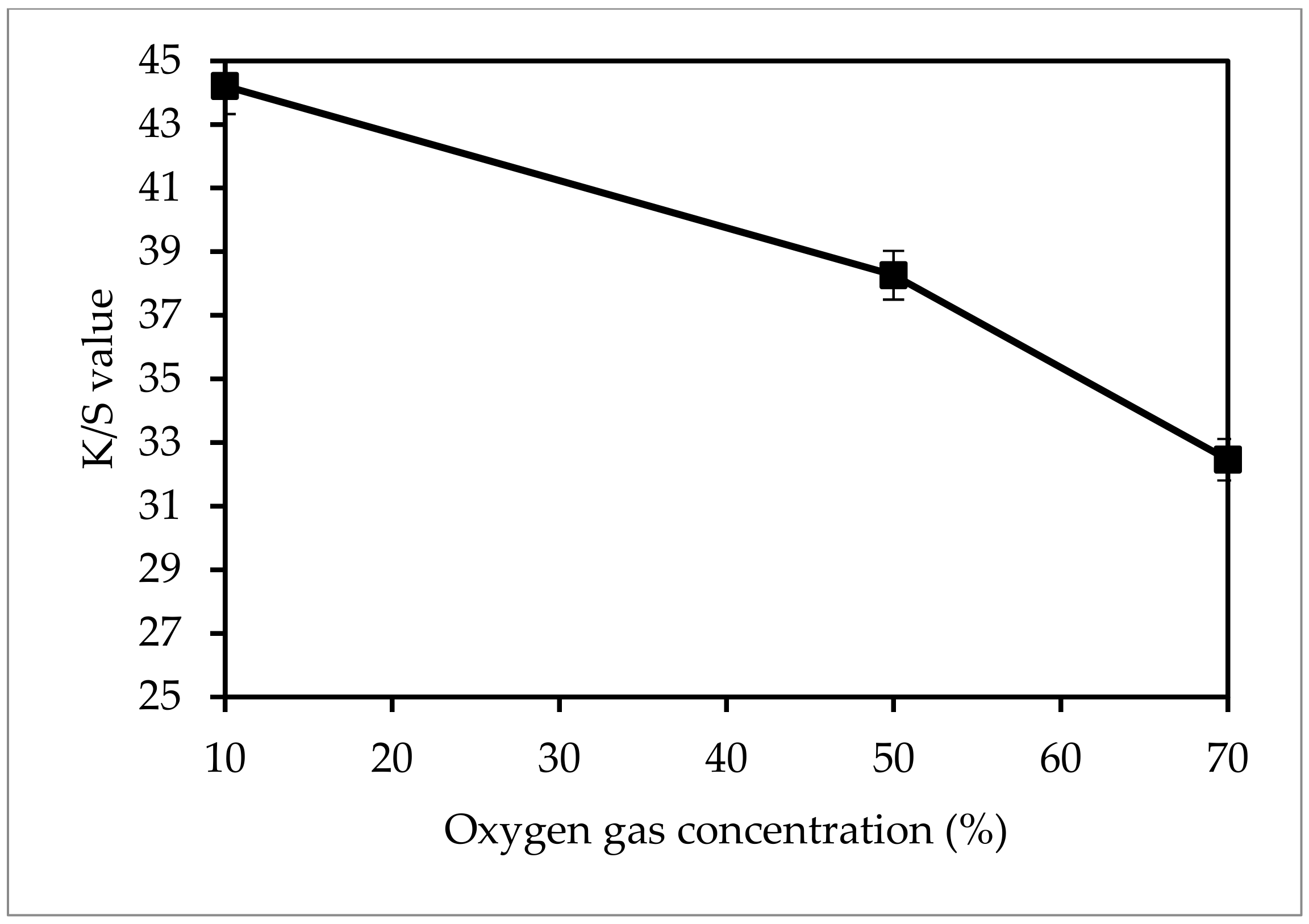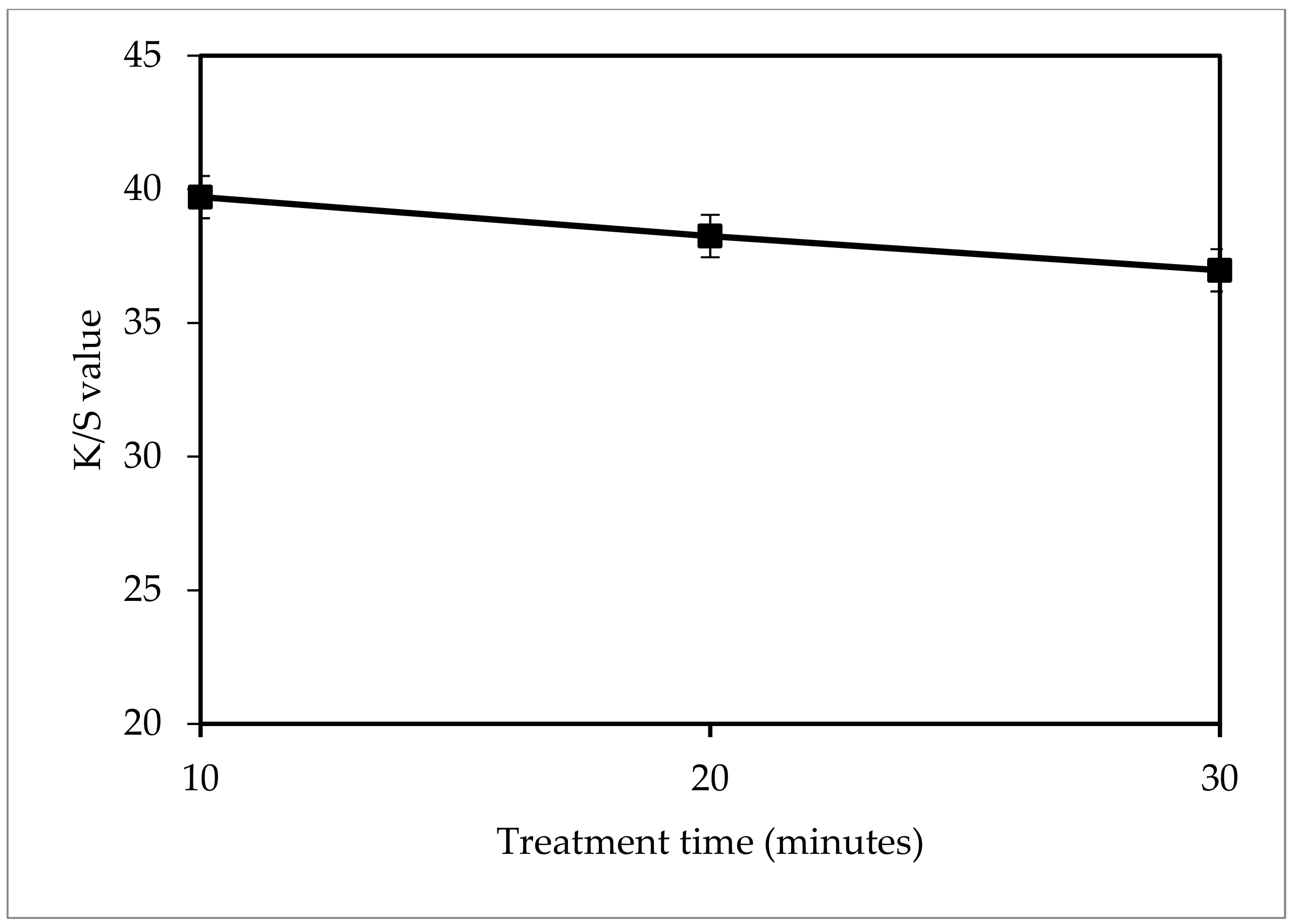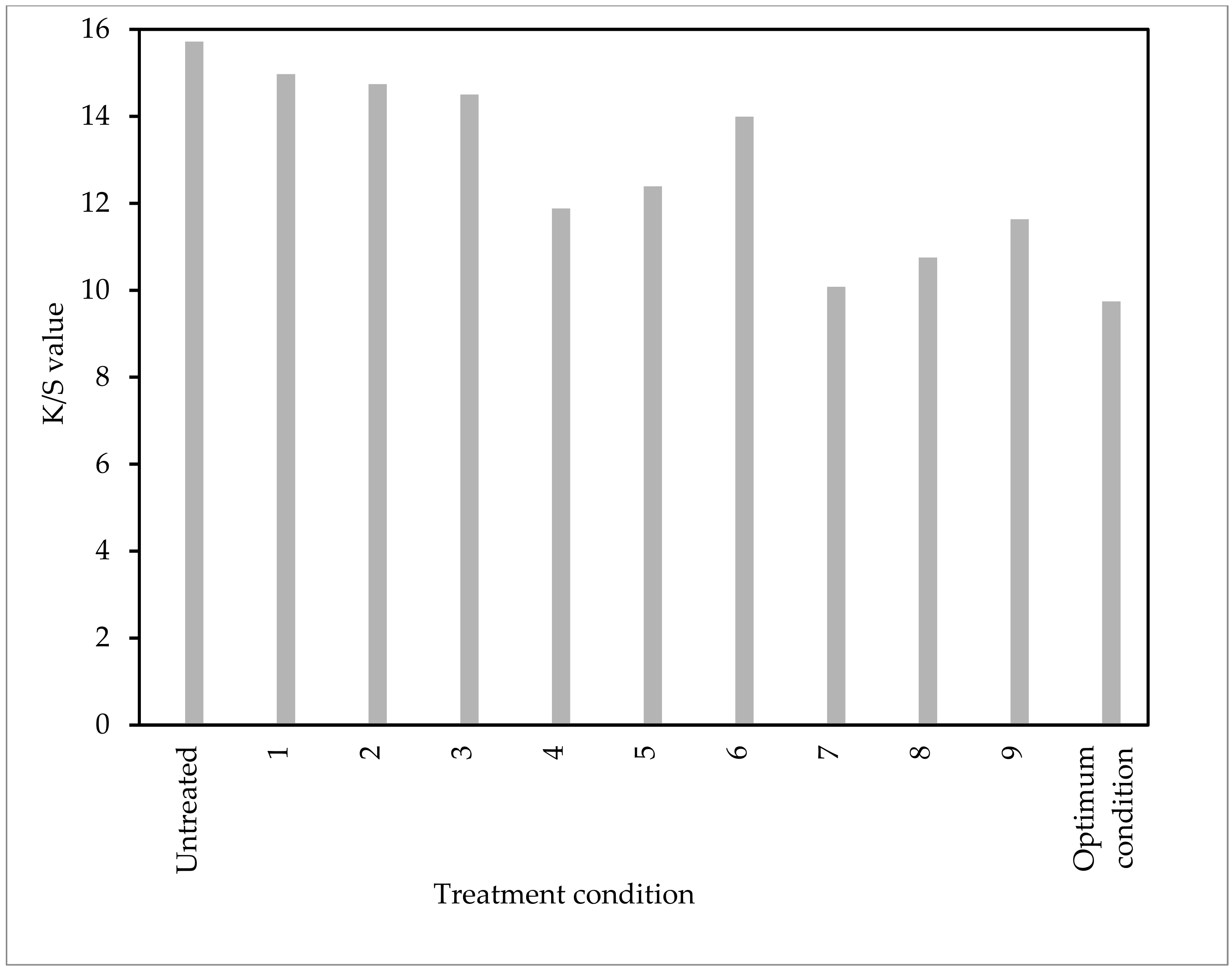A Parameter Study of the Effect of a Plasma-Induced Ozone Colour-Fading Process on Sulphur-Dyed Cotton Fabric
Abstract
1. Introduction
2. Experimental
2.1. Knitted Cotton Fabric and Sulphur Dye
2.2. Dyeing of Knitted Cotton Fabric with Sulphur Dye
2.3. Plasma-Induced Ozone Colour-Fading Treatment
2.4. Colour Measurement
2.5. Colour Levelness Measurement
3. Results and Discussion
3.1. Optimum Conditions for Colour Fading of Sulphur-Dyed Knitted Cotton Fabric Based on Plasma-Induced Ozone Colour-Fading Treatment
3.2. Colour Properties Measurement
4. Conclusions
Author Contributions
Acknowledgments
Conflicts of Interest
References
- 2012 Levi Strauss & CO. Available online: http://store.levi.com/waterless/index.html (accessed on 12 February 2018).
- Card, A.; Moore, M.A.; Ankeny, M. Performance of garment washed denim blue jeans. AATCC Rev. 2005, 5, 23–27. [Google Scholar]
- Sariisik, M. Use of cellulases and their effects on denim fabric properties. AATCC Rev. 2004, 4, 24–29. [Google Scholar]
- Cavaco-Paulo, A. Mechanism of cellulase action in textile processes. Carbohydr. Polym. 1998, 37, 273–277. [Google Scholar] [CrossRef]
- Özdil, N.; Özdoğan, E.; Öktem, T. Effects of enzymatic treatment on various spun yarn fabrics. Fibres Text. East. Eur. 2003, 11, 58–61. [Google Scholar]
- Kan, C.W.; Cheung, H.F.; Chan, Q. A study of plasma-induced ozone treatment on the colour fading of dyed cotton. J. Clean. Prod. 2016, 112, 3514–3524. [Google Scholar] [CrossRef]
- Kan, C.W.; Lam, C.F.; Chan, C.K.; Ng, S.P. Using atmospheric pressure plasma treatment for treating grey cotton fabric. Carbohydr. Polym. 2014, 102, 167–173. [Google Scholar] [CrossRef] [PubMed]
- Shen, M.; Wang, L.; Chen, F.; Long, J.J. Effect of low-temperature oxygen plasma on the degumming of ramie fabric. J. Clean. Prod. 2015, 92, 318–326. [Google Scholar] [CrossRef]
- Shen, M.; Wang, L.; Long, J.J. Biodegumming of ramie fiber with pectinases enhanced by oxygen plasma. J. Clean. Prod. 2015, 101, 395–403. [Google Scholar] [CrossRef]
- Pasquet, V.; Behary, N.; Perwuelz, A. Environmental impacts of chemical/ecotechnological/biotechnological hydrophilization of polyester fabrics. J. Clean. Prod. 2014, 65, 551–560. [Google Scholar] [CrossRef]
- Morent, R.; De Geyter, N.; Verschuren, J.; De Clerck, K.; Kiekens, P.; Leys, C. Non-thermal plasma treatment of textiles. Surf. Coat. Technol. 2008, 202, 3427–3449. [Google Scholar] [CrossRef]
- Wan, C.C.; Lin, L.H.; Chen, C.W.; Lo, Y.C. Surface modification of poly(lactic acid) fabrics with plasma pretreatment and chitosan/siloxane polyesters coating for color strength improvement. Polymers 2017, 9, 371. [Google Scholar]
- Chen, C.; Jia, L.; Liu, R.; Chen, X.; Jin, C.; Liu, H.; Feng, C.; Zhang, C.; Qiu, Y. The effects of humidity on the surface modification of wool fabric through atmospheric pressure plasma jet. Fibers Polym. 2016, 17, 1181–1185. [Google Scholar] [CrossRef]
- Kan, C.W.; Cheung, H.F.; Kooh, F.M. An investigation of color fading of sulphur-dyed cotton fabric by plasma treatment. Fibers Polym. 2017, 18, 767–772. [Google Scholar] [CrossRef]
- Zhang, J.B.; Zheng, Z.; Zhang, Y.N.; Feng, J.W.; Li, J.H. Low-temperature plasma-induced degradation of aqueous 2,4-dinitrophenol. J. Hazard. Mater. 2008, 154, 506–512. [Google Scholar] [CrossRef] [PubMed]
- Khan, H.; Ahmad, N.; Yasar, A.; Shahid, R. Advanced oxidative decolorization of red Cl-5B: Effects of dye concentration, process optimization and reaction kinetics. Pol. J. Environ. Stud. 2010, 19, 83–92. [Google Scholar]
- Eren, H.A.; Ozturk, D. The evaluation of ozonation as an environmentally friendly alternative for cotton preparation. Text. Res. J. 2010, 81, 512–519. [Google Scholar] [CrossRef]
- Piccoli, H.H.; de Souza, A.U.U.; de Souza, S.M.A.G.U. Bleaching of knitted cotton fabric applying ozone. Ozone Sci. Eng. 2015, 37, 170–177. [Google Scholar] [CrossRef]
- Radetic, M.; Jovancic, P.; Puac, N.; Petrovic, Z.L.; Saponjic, Z. Plasma-induced decolorization of indigo-dyed denim fabrics related to mechanical properties and fiber surface morphology. Text. Res. J. 2009, 79, 558–565. [Google Scholar] [CrossRef]
- Kan, C.W.; Yuen, C.W.M. Effect of atmospheric pressure plasma treatment on the desizing and subsequent colour fading process of cotton denim fabric. Color. Technol. 2012, 128, 356–363. [Google Scholar] [CrossRef]
- Robinson, T.; McMullan, G.; Marchant, R.; Nigam, P. Remediation of dyes in textiles effluent: a critical review on current treatment technologies with a proposed alternative. Bioresour. Technol. 2001, 77, 247–255. [Google Scholar] [CrossRef]
- Farooq, A.; Ali, S.; Abbas, N.; Fatima, G.A.; Ashraf, M.A. Comparative performance evaluation of conventional bleaching and enzymatic bleaching with glucose oxidase on knitted cotton fabric. J. Clean. Prod. 2013, 42, 167–171. [Google Scholar] [CrossRef]
- Chan, C.M.; Ko, T.M.; Hiraoka, H. Polymer surface modification by plasma and photons. Surf. Sci. Rep. 1996, 24, 1–54. [Google Scholar] [CrossRef]
- Cheung, H.F.; Lee, Y.S.; Kan, C.W.; Yuen, C.W.M.; Yip, J. Colour properties of plasma-induced ozone fading of cotton fabric. Adv. Mater. Res. 2013, 811, 3–8. [Google Scholar] [CrossRef]
- Cheung, H.F.; Lee, Y.S.; Kan, C.W.; Yuen, C.W.M.; Yip, J. Effect of plasma-induced ozone treatment on the colour yield of textile fabric. Appl. Mech. Mater. 2013, 387, 131–134. [Google Scholar] [CrossRef]
- G2 Technology. Available online: https://www.jeanologia.com/portfolio/g2-prueba/ (accessed on 13 February 2018).
- Vinisha Rani, K.; Hari Prakash, N.; Solomon, I.; Sarma, B.; Sarma, A. Surface modifications of natural Kanchipuram silk (pattu) fibers using glow discharge air plasma. Fibers Polym. 2016, 17, 52–58. [Google Scholar] [CrossRef]
- Bhat, N.V.; Netravali, A.N.; Gore, A.V.; Sathianarayanan, M.P.; Arolkar, G.A.; Deshmukh, R.R. Surface modification of cotton fabrics using plasma technology. Text. Res. J. 2011, 81, 1014–1026. [Google Scholar] [CrossRef]
- Inbakumar, S.; Morent, R.; De Geyter, N.; Desmet, T.; Anukaliani, A.; Dubruel, P.; Leys, C. Chemical and physical analysis of cotton fabrics plasma-treated with a low pressure DC glow discharge. Cellulose 2010, 17, 417–426. [Google Scholar] [CrossRef]
- Zhou, C.E.; Kan, C.W.; Yuen, C.W.M. Orthogonal analysis for rechargeable antimicrobial finishing of plasma pretreated cotton. Cellulose 2015, 22, 3465–3475. [Google Scholar] [CrossRef]
- Kan, C.W. Evaluating antistatic performance of plasma-treated polyester. Fibers Polym. 2007, 8, 629–634. [Google Scholar] [CrossRef]
- Zhou, C.E.; Kan, C.W. Optimizing rechargeable antimicrobial performance of cotton fabric coated with 5, 5-dimethylhydantoin (DMH). Cellulose 2015, 22, 879–886. [Google Scholar] [CrossRef]
- Chong, C.L.; Li, S.Q.; Yeung, K.W. An objective method for the assessment of levelness of dyed materials. J. Soc. Dyers Colour. 1992, 108, 528–530. [Google Scholar] [CrossRef]





| Methods | Advantages | Disadvantages | References |
|---|---|---|---|
| Chemical process e.g., hydrogen peroxide or sodium hypochlorite | Fast operating processes Simplest Application | Most Expensive Wastewater Water Pollution Disposal problem as concentration of sludge Excessive chemicals usage High electrical energy Toxic Chemicals usage (e.g., Acid) Time consuming Inability to create standard designs Not possible on all textile surfaces Loss of quality | [19,20,21,22] |
| Plasma Treatment | Low cost Most rapidly for surface modification No solid waste No air pollution No water pollution Dry operation Wide range of textile surface can be done Even modification result | Modification of the parameters before starting operation Less skilled operating skills | [19,20,23] |
| Level | Process Parameters | ||
|---|---|---|---|
| Oxygen Gas Concentration (%) | Water Content in Fabric (%) | Treatment Time (Minutes) | |
| I | 10 | 35 | 10 |
| II | 50 | 40 | 20 |
| III | 70 | 45 | 30 |
| Test Run | Process Parameters | ||
|---|---|---|---|
| Oxygen Gas Concentration (%) | Water Content in Fabric (%) | Treatment Time (Minutes) | |
| 1 | I | I | I |
| 2 | I | II | II |
| 3 | I | III | III |
| 4 | II | I | II |
| 5 | II | II | III |
| 6 | II | III | I |
| 7 | III | I | III |
| 8 | III | II | I |
| 9 | III | III | II |
| RUI Value | Interpretation |
|---|---|
| <0.2 | Excellent levelness |
| 0.2–0.49 | Good levelness |
| 0.5–1.0 | Poor levelness |
| >1.0 | Bad levelness |
| Test Run | Parameters | K/S Value | ||
|---|---|---|---|---|
| Oxygen Gas Concentration (%) | Water Content in Fabric (%) | Treatment Time (Minutes) | ||
| 1 | I | I | I | 14.97 |
| 2 | I | II | II | 14.74 |
| 3 | I | III | III | 14.50 |
| 4 | II | I | II | 11.88 |
| 5 | II | II | III | 12.39 |
| 6 | II | III | I | 13.99 |
| 7 | III | I | III | 10.08 |
| 8 | III | II | I | 10.75 |
| 9 | III | III | II | 11.63 |
| ∑ in K/S Value | Parameters | |||
| Oxygen Gas Concentration (%) | Water Content in Fabric (%) | Treatment Time (Minutes) | ||
| ∑ I | 44.21 | 36.93 | 39.71 | |
| ∑ II | 38.26 | 37.88 | 38.25 | |
| ∑ III | 32.46 | 40.12 | 36.97 | |
| Difference | 11.75 | 3.19 | 2.74 | |
| CIE L* | CIE a* | CIE b* | ΔE | Levelness (RUI) | |
|---|---|---|---|---|---|
| Untreated | 58.15 | 1.40 | −12.86 | - | 0.30 |
| Plasma-induced ozone colour-fading treated (sample) | 79.35 | −0.86 | 7.47 | 29.46 | 0.30 |
© 2018 by the authors. Licensee MDPI, Basel, Switzerland. This article is an open access article distributed under the terms and conditions of the Creative Commons Attribution (CC BY) license (http://creativecommons.org/licenses/by/4.0/).
Share and Cite
Zhong, D.; Liu, Y.-H.; Cheung, N.-T.; Kan, C.-W.; Chua, H. A Parameter Study of the Effect of a Plasma-Induced Ozone Colour-Fading Process on Sulphur-Dyed Cotton Fabric. Processes 2018, 6, 81. https://doi.org/10.3390/pr6070081
Zhong D, Liu Y-H, Cheung N-T, Kan C-W, Chua H. A Parameter Study of the Effect of a Plasma-Induced Ozone Colour-Fading Process on Sulphur-Dyed Cotton Fabric. Processes. 2018; 6(7):81. https://doi.org/10.3390/pr6070081
Chicago/Turabian StyleZhong, Dan, Yao-Hui Liu, Ngan-Ting Cheung, Chi-Wai Kan, and Hong Chua. 2018. "A Parameter Study of the Effect of a Plasma-Induced Ozone Colour-Fading Process on Sulphur-Dyed Cotton Fabric" Processes 6, no. 7: 81. https://doi.org/10.3390/pr6070081
APA StyleZhong, D., Liu, Y.-H., Cheung, N.-T., Kan, C.-W., & Chua, H. (2018). A Parameter Study of the Effect of a Plasma-Induced Ozone Colour-Fading Process on Sulphur-Dyed Cotton Fabric. Processes, 6(7), 81. https://doi.org/10.3390/pr6070081





